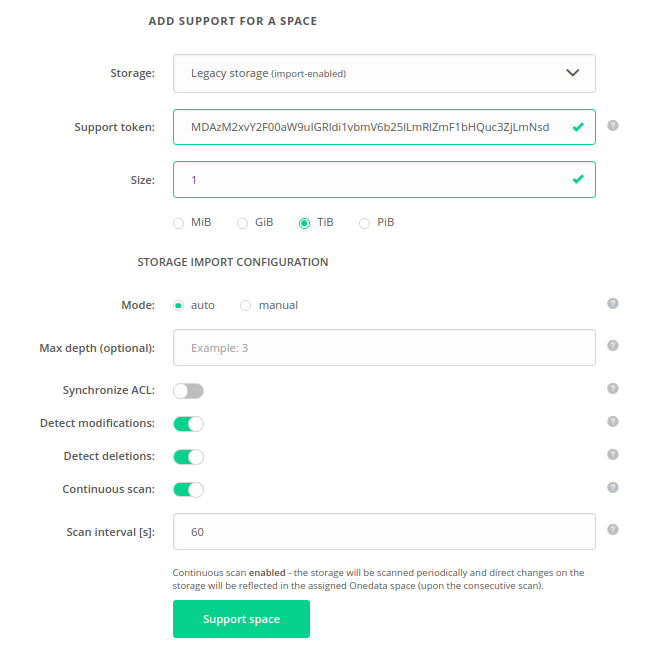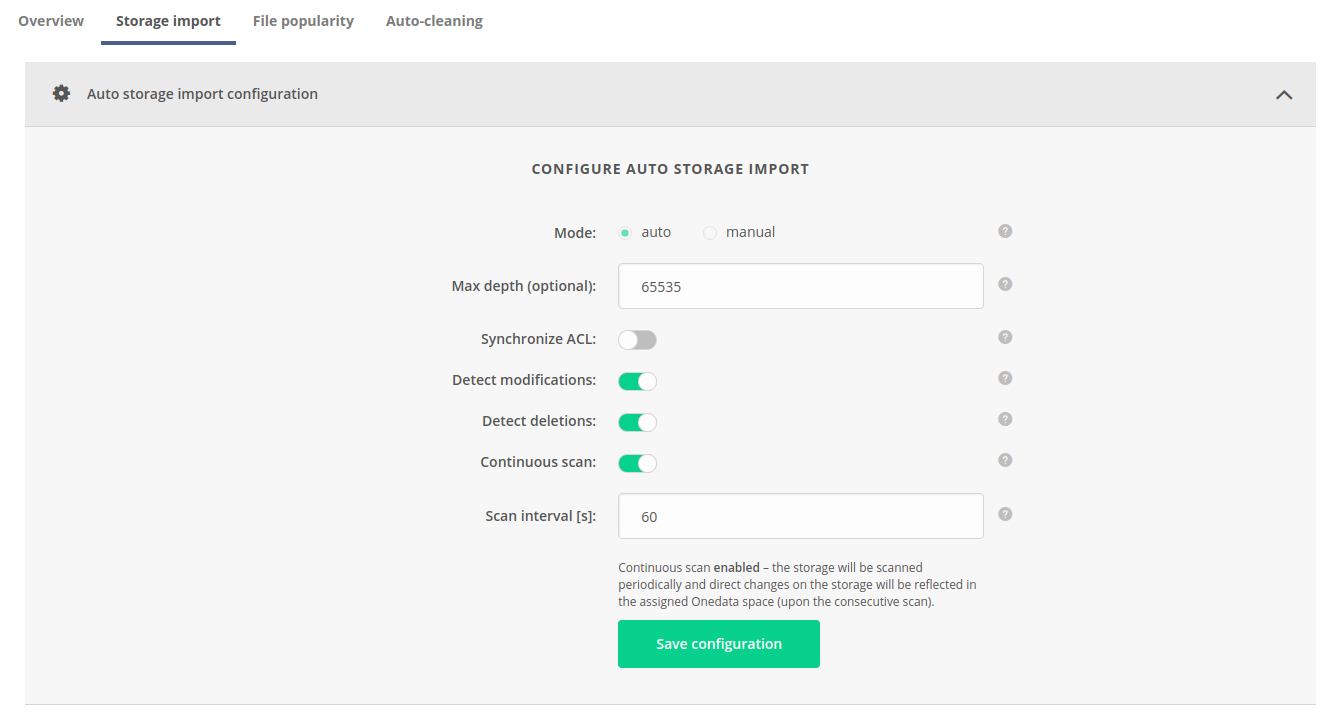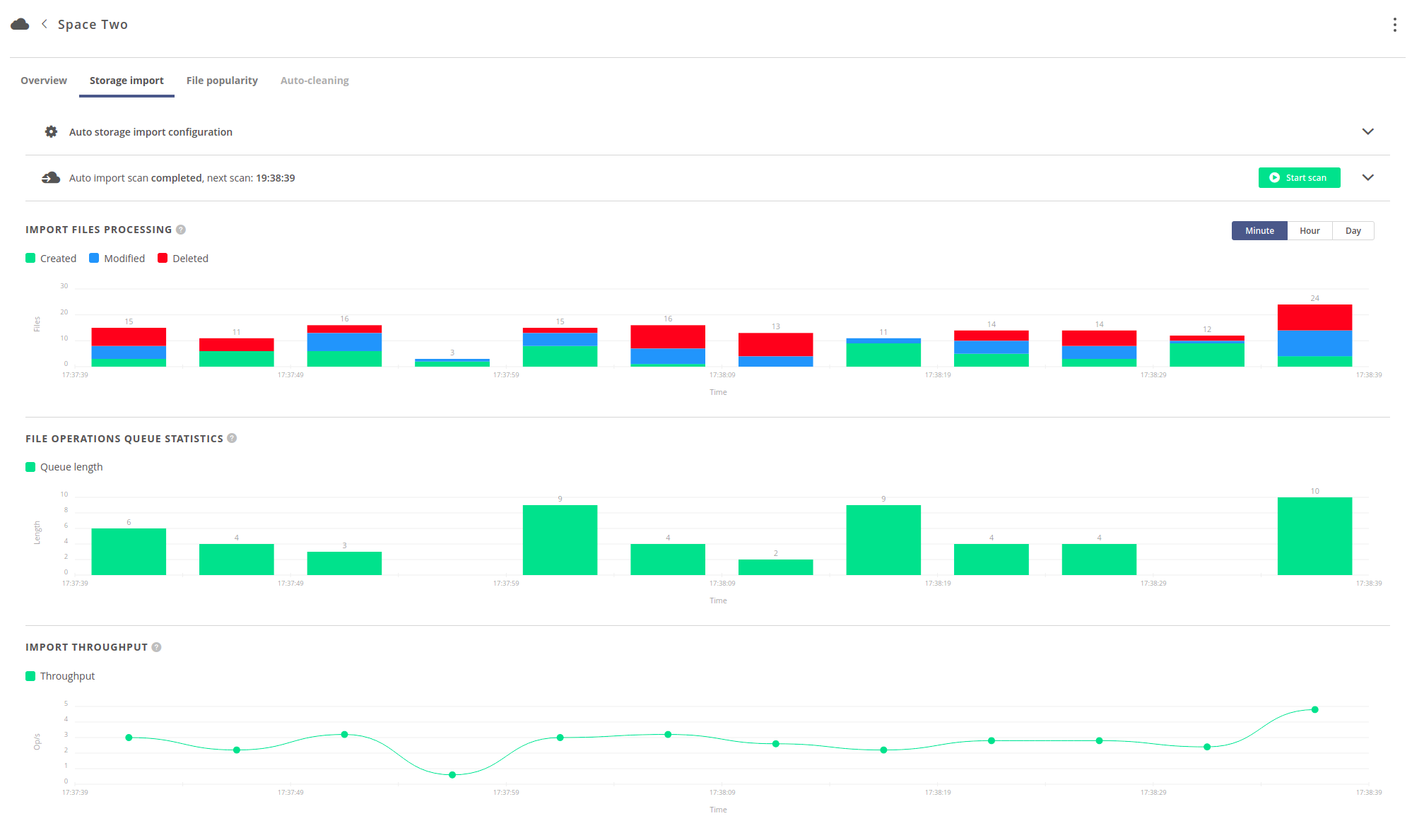# Storage import
Storage import is dedicated for importing files located on a storage by registering them in the space supported by the storage. The file registration process does not copy any data, it simply creates the necessary metadata so that the files pre-existing on the storage are reflected and accessible in the supported space. It is possible to configure the storage to detect consecutive changes made directly on the storage after the initial import (during the space lifecycle) — using the continuous scan option, by manually triggering scans or by re-registering files.
This functionality should be used in two setups:
- There is a legacy data collection located on the storage backend, which should be imported into a space.
- The data on storage backend is to be modified directly by third party applications, bypassing the provider interfaces, and the changes should be reflected in the supported space.
NOTE: In other setups, it is not recommended to enable storage import, as it will introduce unnecessary overheads. Essentially, the regular storage setup in Onedata assumes that the supporting storage is initially empty and dedicated exclusively for being accessed by the Oneprovider software. This should be the preferred setup, except for the two above-mentioned cases.
storage import can be enabled only if the space is supported with an Imported storage.
# Configuration
There are 2 possible modes of storage import: manual and auto. The mode is chosen when the space is being supported with an Imported storage as presented in the below picture.
NOTE: storage import mode cannot be changed during the space lifecycle.

# Manual storage import
In case of manual mode, the files must be registered manually by the space users. Registration of directories is not supported.
This option is preferred when only a part of the data collection is to be imported, but required if the storage backend does not support automatic import scans.
# Storage configuration for manual import
Manual storage import is supported on the following storage backends:
POSIXGlusterFSNull deviceWebDAVXRootDHTTPS3SwiftCeph RADOS
NOTE: The storage must have canonical path type. Moreover, on object storage backends: S3, SWIFT and Ceph RADOS the
Block sizeparameter must be set to0!
# Auto storage import
In case of auto mode, the storage is automatically scanned and data is imported from storage backend into the assigned space.
# Storage configuration for auto import
Auto storage import is supported on the following storage backends:
POSIXGlusterFSNull deviceWebDAVXRootDS3
NOTE: The storage must have canonical path type. Moreover, on S3 the
Block sizeparameter must be set to0!
# Configuration
The configuration of auto storage import can be set when supporting the space, as presented in the
previous picture. It can also be modified later in the
Spaces -> "Space Name" -> Storage import > Auto storage import configuration tab, as presented below:

The available configuration options are:
Max depth— Maximum depth of filesystem tree that will be traversed during the scan. By default, it is 65535.Synchronize ACL— Enables import of NFSv4 ACLs. Note that this option requires proper mappings in LUMA DB.Detect modifications— If disabled, the storage will be treated as immutable — changes of already imported files will not be detected. Relevant only if more than one scan is performed.Detect deletions— Flag determining that deletions of already imported files will be detected and reflected. Relevant only if more than one scan is performed.Continuous scan— Indicates if the data on the storage backend should be imported into the space periodically. Continuous import guarantees data integrity if direct modifications on the storage backend are to be made during the space lifecycle.Scan interval— Period between subsequent scans in seconds (counted from end of one scan till beginning of the following), relevant only ifContinuous scanis enabled.
# Last scan summary
Below the configuration tab, there is information about current or last finished scan: its status, start & stop times
and the number all of processed files (Processed items) as well as the total number of files residing on the storage
during the scan (Total storage items).
Processed items is a sum of Created items, Modified items, Unmodified items, Deleted items and Failed items
counters, which are presented in the right column of the tab. Failed items is the number of files for which processing has failed.
Total storage items is a sum of Created items, Modified items and Unmodified items counters.
File counters include both directories and regular files.
If the Continuous scan is enabled, it also displays the estimated time of the next scan.

# Starting a scan on demand
It is possible to forcefully start a single scan of auto storage import, even if Continuous scan is disabled
(use the green button). The scan will be started with current configuration.

NOTE: A new scan can be started only if there is no scan in progress for the space.
# Stopping a scan on demand
It is also possible to forcefully stop the current scan of auto storage import (use the red button).

NOTE: Stopping the scan is asynchronous — may take some time and does not guarantee instant effect.
# Statistics
Progress of the auto storage import can be observed on three charts, as shown below. It is possible to change the time resolution of the charts in the upper right corner of the charts view.
